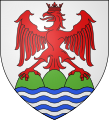Base (heraldry)

The base, more formally the terrace in base[1] or champagne,[2] is a heraldic charge that occupies the lower third of the field. It is in that sense the inverse correlate of the chief. In French heraldry, the champagne is considered an "honourable ordinary" (pièce honorable),[3] but in English heraldry, it is frequently omitted from lists of the honourable ordinaries, and grouped, if at all, with the subordinaries.[4] The diminutive of the base, occupying one half the height of the ordinary, is termed plaine in French heraldry.[5] Another, now less common, English language term for the base is the foot,[6] a usage the recalls the German Schildfuß, Danish skjoldfod, and Dutch schildvoet.
In English heraldry, the terms base, terrace in base, and champagne are synonyms that include both charges with a straight-line upper edge running parallel to the chief and those with an upper edge curved or otherwise varied. Standard variations are the mount and trimount.[7] In French heraldry in contrast, the terms champagne and its diminutive plaine are reserved for those with straight upper edges and the term terrasse (terrace in base) for those with curved or otherwise varied upper edges.[8] Champagnes that take step-wise lines of division or variation are blasoned in French as champagne pignonnée.[9] The latter (terrasse) are furthermore classed as mobile charges rather than honourable ordinaries.
Gallery
[edit]Coat of arms
[edit]Mount
[edit]Champagne pignonée
[edit]Plaine
[edit]-
Méounes-lès-Montrieux (terrasse isolée[10])
On flags
[edit]-
Flag of the former Republic of Anguilla (1967–1969)
-
Flag of the City of Alexandria, Egypt
-
Flag of Bosbüll, Schleswig-Holstein, Germany
-
Flag of Gibraltar, United Kingdom
-
Flag of the Canadian Broadcasting Corporation
-
Flag of the Opole Voivodeship, Poland (civil)
-
Flag of Saratov Oblast, Russia
-
Ensign of the Netherlands Coast Guard
-
Flag of Belarus
See also
[edit]References
[edit]- ^ Brault, Gerard J. (1972). Early Blazon. Oxford University Press. p. 138.
- ^ Rothery, Guy Cadogan (1915). A. B. C. of Heraldry. London: Stanley Paul & Co. p. 327.
- ^ Woodward, John; Burnett, George (1892). A Treatise on Heraldry, British and Foreign: With English and French Glossaries. Edinburgh: W. & A. K. Johnston. p. 311.
- ^ Woodward, John (1896). A Treatise on Heraldry, British and Foreign: With English and French Glossaries. Vol. 1. Edinburgh / London: W. & A. K. Johnston. p. 126.
- ^ de Mailhol, Dayre (1895). Dictionnaire historique et héraldique de la noblesse française. Paris: Direction & Redaction [Impr. Ch. Lépice]. pp. 61–62.
- ^ Barron, Oswald (1911). . Encyclopædia Britannica. Vol. 13 (11th ed.). pp. 311–330.
- ^ Elvin, Charles Norton (1889). A Dictionary of Heraldry: With upwards of two thousand five hundred illustrations. London: Kent & Co. p. 91.
- ^ de Mailhol, Dayre (1895). Dictionnaire historique et héraldique de la noblesse française. Paris: Direction & Redaction [Impr. Ch. Lépice]. pp. 61–62.
- ^ Gheusi, Pierre-Barthélemy (1892). Le blason héraldique: Manuel nouveau de l'art héraldique de la science du blason et de la polychromie féodale d'après les règles du moyen age avec 1300 gravures et un armorial. Paris: Librairie de Firmin Didot et c. pp. 64, fig. 99.
- ^ de Mailhol, Dayre (1895). Dictionnaire historique et héraldique de la noblesse française. Paris: Direction & Redaction [Impr. Ch. Lépice]. p. 186.

























![Méounes-lès-Montrieux (terrasse isolée[10])](http://upload.wikimedia.org/wikipedia/commons/thumb/3/3c/Blason_ville_fr_M%C3%A9ounes-l%C3%A8s-Montrieux_%28Var%29.svg/109px-Blason_ville_fr_M%C3%A9ounes-l%C3%A8s-Montrieux_%28Var%29.svg.png)











